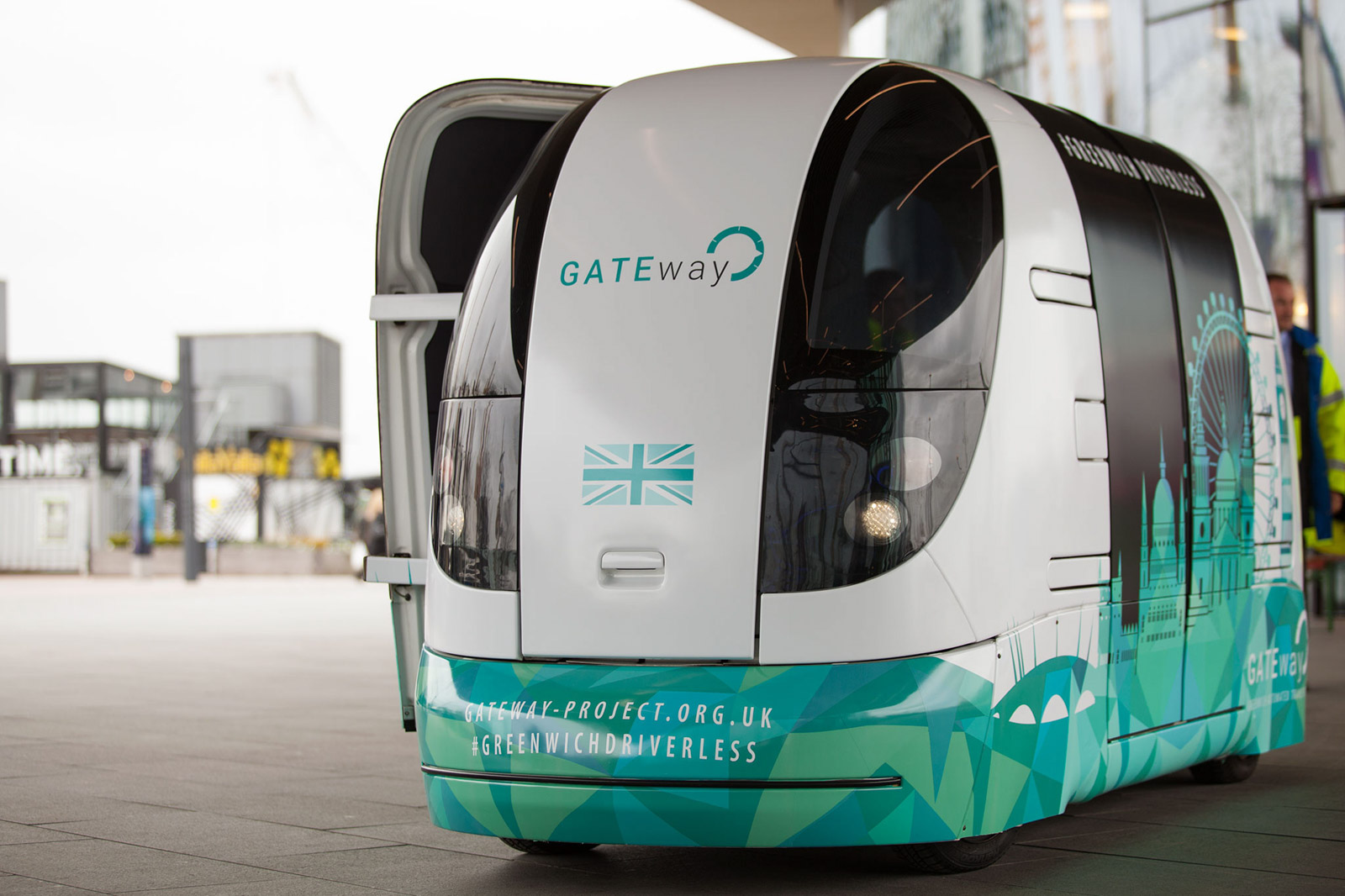Our mission
To understand how automated vehicles can fit into our future urban mobility needs and the barriers we must overcome before these vehicles become a reality on our roads.
What we did
We conducted a number of different trials to understand how people respond, engage with and accept automated vehicles and explored the potential impact this technology could have on our cities.
How it worked
Our GATEway driverless pods used a combination of sensors, cameras, lasers and software to safely navigate their way between leisure sites and residential locations around the Greenwich Peninsular.
Who was involved?
GATEway comprised a consortium of leading companies and academic institutions. The project was led by TRL, the UK’s Transport Research Laboratory, which has over 50 years’ experience in vehicle automation. Other partners in the consortium included:

Royal Borough of Greenwich, Royal College or Art, University of Greenwich, RSA, O2, Gobotix, Commonplace, Westfield, Heathrow, DG Cities, Oxbotica, Fusion Processing, Shell, Imperial College London
The project was also supported by a high quality, multidisciplinary advisory group, chaired by Lord Borwick of Hawkshead – who has led debates in the House of Lords on vehicle automation. This group included representatives from the police, road safety organisations, vehicle manufacturers, road operators and public authorities.
About the project
The GATEway project is now complete. The project saw a fleet of driverless pods providing a shuttle service around the Greenwich Peninsula to understand public acceptance of, and attitudes towards, driverless vehicles.
In a world first, members of the public were invited to take part in the research trial through riding in or engaging with the pods and sharing their opinions and experiences.
In the final phase of the GATEway project, four driverless pods navigated a 3.4km route around the Greenwich Peninsula, using advanced sensors and state-of-the-art autonomy software to detect and avoid obstacles as they picked up and dropped off passengers at four designated pod stops.
Developed by British companies Westfield Sportscars and Heathrow Enterprises, and powered by Fusion Processing technology, the pods had no steering wheels or typical driver controls. Instead, Fusion’s software, CAVstar®, combines GPS with radar (for long range) and LIDAR (for close range) to enable the pods to detect and safely negotiate objects in their path. This also allows the pods to operate in adverse weather conditions, or even in the dark – a global first for this technology.
The shuttle trial was only one part of the GATEway project. Other trials included: automated urban deliveries; remote teleoperation demonstrations, exploring how automated vehicle systems work for people with additional travel needs; and high-fidelity simulator tests to investigate how drivers of regular vehicles respond and adapt their behaviour to the presence of automated vehicles on the roads.
Research from the GATEway project has helped advance the UK’s position in the autonomous vehicles revolution, but what makes it truly unique is its primary focus on people. Through exploring how we feel about using and sharing space with autonomous vehicles, GATEway provided valuable sociological insight into mobility solutions and the part they could play in our cities of the future.
The GATEway Project builds on more than fifty years of research into automated vehicles by TRL and operates within the Smart Mobility Living Lab: London a world-class test bed and real-world environment for the development and validation of new mobility solutions enabled by connected and automated vehicle technology.
London’s Smart Mobility Living Lab is part of a long-term commitment to attract inward investment and create a compelling route to market for innovators. This began with the GATEway (Greenwich Automated Transport Environment) project which, funded by government and industry, has demonstrated several ‘firsts’ in engaging with the public in the trialling of CAVs. However, as suggested by its acronym, the intention of the GATEway project was always to create a high profile, fully featured and enduring test environment where the capabilities and benefits of CAVs could be evaluated.
GATEway was jointly funded by government and industry. The government’s £100m Intelligent Mobility fund is administered by the Centre for Connected and Autonomous Vehicles (CCAV) and delivered by the UK’s innovation agency, Innovate UK.
It was one of three projects awarded by Innovate UK under its ‘Introducing driverless cars to UK roads’ competition.
Project objectives
Demonstrate
The safe and efficient integration of sophisticated automated transport systems into complex real world smart city environments.
Understand
The technical, cultural, societal and legal challenges and barriers to adoption surrounding automated vehicles.
Inspire
Industry, public bodies and the wider public to engage with autonomous transport technology.
Generate
Valuable, exploitable knowledge of the systems required for the effective validation, deployment, management and integration of automated transport within a smart city environment.
Create
A validated test bed in the heart of London for the evaluation of next generation automated transport systems, including the detailed testing protocols and benchmark data for independent verification of automated systems.
Position
UK PLC at the forefront of the global connected and autonomous vehicle marketplace, encouraging inward investment and job creation.
Content
There were lots of vidoes taken of this groundbreaking trial. Find them all on the GATEway YouTube Channel.
Publications
D1.3 GATEway Project: Final Report
D2.1 The Security of Driverless Cars
D2.2 Safety and Insurance Report PPR859
D3.10 DG Cities Last Mile Solutions Modelling Report
D3.2.0 RCA Background Research Report
D3.2.2 RCA Summer Workshop Report
D3.2.8 RCA Trial 1 Workshop In-vehicle Report
D3.3 RCA Student Internship Report
D3.4.1 RCDLA Car Culture Google Interviews
D3.4.2 RCDLA Car Culture Social Media Report
D3.4.3 CDR Autonomous Car Design Contexts
D3.6 Commonplace Sentiment Mapping
D3.7 TRL Workshop Findings Report
D4.6 Driver responses to encountering automated vehicles in an urban environment
D5.3a TRL Trial 1 Project Report_PPR858
D5.3b RCA_Trial 2 Auto Valet Parking

